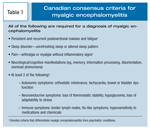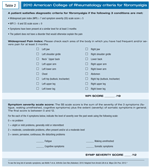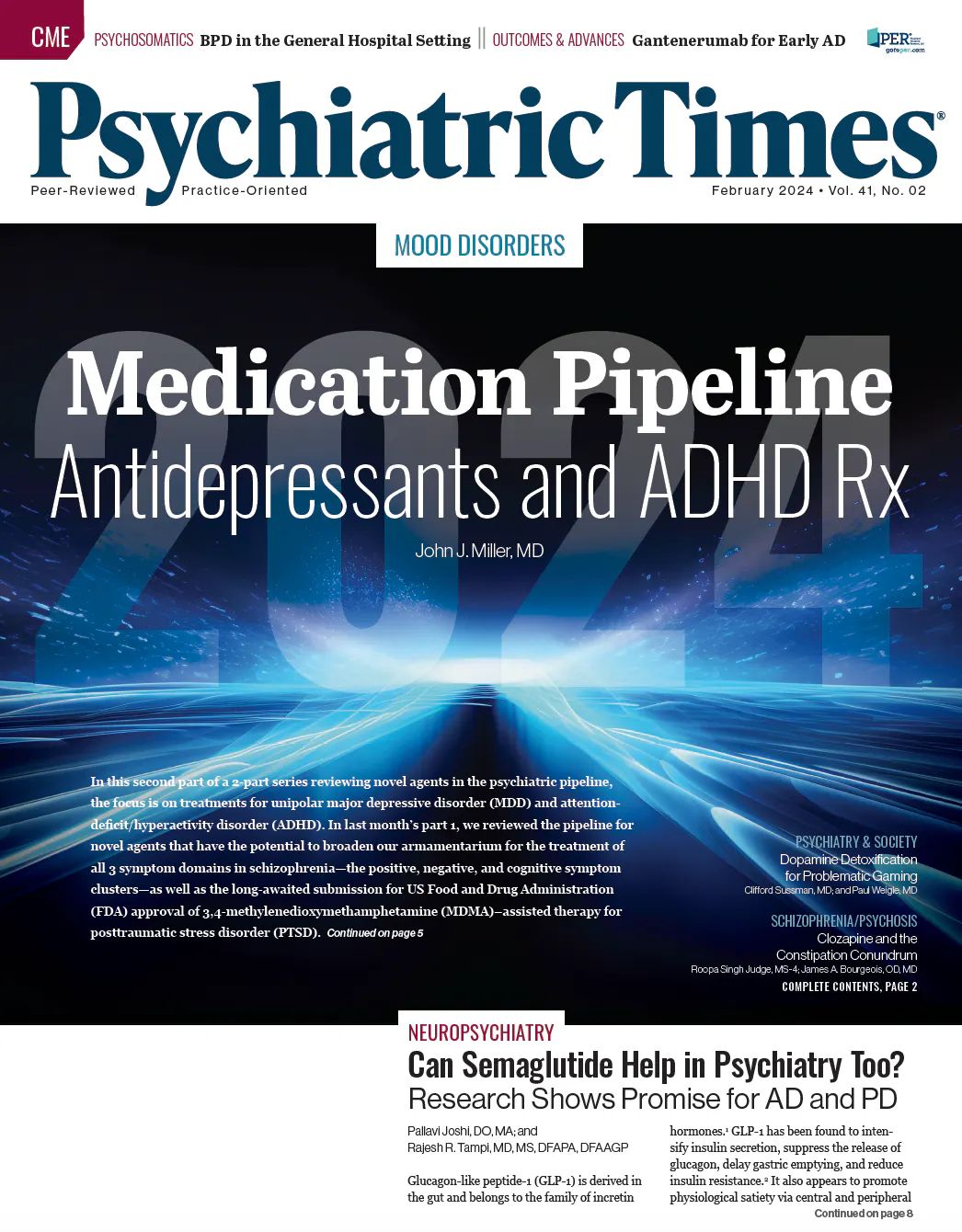Publication
Article
Psychiatric Times
Identifying and Treating Common Psychiatric Conditions Comorbid with Myalgic Encephalomyelitis and/or Fibromyalgia
Author(s):
This article reviews the diagnostic criteria for both myalgic encephalomyelitis and fibromyalgia and describes how to differentiate them from depressive and anxiety disorders, the psychiatric conditions with which they are most often confused.

This article reviews the diagnostic criteria for both myalgic encephalomyelitis (ME) (ie, chronic fatigue syndrome) and fibromyalgia (FM) and describes how to differentiate them from depressive and anxiety disorders, the psychiatric conditions with which they are most often confused. The patients in the following Case Vignettes have ME and/or FM; not all have a psychiatric condition.
Despite thousands of peer-reviewed papers documenting their unique characteristics and pathophysiology, ME and FM continue to be mistaken for psychiatric conditions. This is problematic because it can delay accurate diagnosis and appropriate treatment, often for years. Although they have some symptoms in common (eg, fatigue, cognitive problems, unrefreshing sleep), ME and FM differ from each other and from all known psychiatric conditions. Diagnostic clarity depends on knowledge of the diagnostic criteria for each condition and identifying the pathognomonic, non-overlapping symptoms.
Diagnostic criteria for myalgic encephalomyelitis
The Canadian Consensus Criteria are used for diagnosis of ME. These criteria require the concurrent presence of disabling fatigue, postexertional malaise, unrefreshing sleep, muscle or joint pain, mood or cognitive symptoms, and at least 2 of the following: autonomic, neuroendocrine, or immune symptoms (Table 1).1 Postexertional malaise (immediate or delayed), the pathognomonic symptom of ME, is unusual in any psychiatric condition: most psychiatric patients feel better rather than worse after mental or physical exertion. Pain is not a core symptom of any common psychiatric condition but is reported to be elevated in major depression.2 Autonomic, neuroendocrine, and immune symptoms are not common in any psychiatric condition.
What new information does this article provide?
? Myalgic encephalomyelitis (ME) and fibromyalgia (FM) are complex biomedical conditions. Because psychiatric conditions are commonly comorbid, they should be looked for in patients with ME and FM.
What are the implications for psychiatric practice?
? Consider the diagnoses of ME and FM in “psychiatric” patients with a disproportionate number of physical symptoms, especially in those who are not responding as expected to psychiatric interventions.
Diagnostic criteria for fibromyalgia
New criteria for diagnosing FM were published in 2010.3 These criteria eliminate the previously required need for tender points on physical examination and add the criteria of fatigue, unrefreshing sleep, cognitive symptoms, and a long list of somatic symptoms (none of which are specific to FM) to the pathognomonic symptom of widespread pain (Table 2). Since fatigue, unrefreshing sleep, and cognitive symptoms are common to many psychiatric conditions, these new criteria do not aid in the differentiation between FM and a psychiatric diagnosis. A careful review of the entire constellation of symptoms is needed to identify whether the psychological or physical symptoms predominate. In patients with aching, tiring pain all over as the primary presenting symptom in combination with several other somatic symptoms, FM should be considered.
CASE VIGNETTES
Maggie, aged 51, has suffered from chronic pain for several years since a skiing accident resulted in multiple surgeries on her broken ankle. In the past few years, this pain has become more generalized and is now associated with fatigue and cognitive problems. As she became increasingly unable to work, play, and socialize, depression developed. Now she feels “sick and tired” all the time with “pain all over” and lacks hope for the future.
_____________________
Ben, aged 30, was a football star in college before coming down with Epstein Barr virus infection. He did not rest when he became ill because it was right before playoffs. He never fully recovered from this infection. He continues to feel “flu-like” most of the time and his energy “crashes” anytime he tries to do even modest amounts of exercise, such as playing with his young children. Since becoming ill, he has noticed a generalized worry about life. Even though his wife works and he has good family support, he cannot suppress the worry that “it will all fall apart.”
______________________
Joyce, aged 40, developed fatigue, “brain fog,” and “pain all over” after the difficult, premature birth of her second child. The child did not sleep through the night until he was 5 years old. When this child was 6 and starting school, Joyce thought she would finally be able to catch up on her sleep and rest. However, her health unaccountably took a turn for the worse and she experienced increased fatigue, orthostatic dizziness, difficulty in regulating temperature, and severe postexertional malaise. Her family physician diagnosed depression and prescribed an antidepressant. This, and other subsequent psychotropic trials, made her symptoms worse. She says she does not feel depressed, just really ill.
Prevalence of comorbidity
ME and FM can exist alone or together or can be comorbid with psychiatric conditions. The prevalence of Axis I conditions, particularly mood disorders, is higher in patients who have ME and FM than in healthy controls. The prevalence of psychiatric comorbidity is about the same in patients with ME as in patients with other chronic medical conditions; however, the rates are higher in patients who have FM. Estimates of comorbidity vary widely from study to study, which may be due to differences in sample types, variance in assessment tools for psychiatric diagnosis, and varying criteria being used for ME and FM. The variance is great enough that trying to estimate rates for individual comorbid psychiatric conditions is not helpful.
The prevalence of concurrent Axis I conditions among patients with ME ranges from 25% to 57%.4-6 The upper estimate comes from an epidemiological study that used flawed diagnostic criteria for ME.5,7 There is no evidence of any special relationship between ME and any psychiatric condition. In persons with ME, the prevalence of personality disorders is similar to that in the general population (less than10%) and much lower than that found in patients with depression.8,9
Rates of depression and anxiety are also variable in FM. The prevalence of “depressive disorders” ranges from 20% to 80% and of “anxiety disorders,” from 13% to 64%.10 Axis II diagnoses are identified in 8.7% of patients with FM.11 There is some overlap in the genetics and family clustering of FM, MDD, and dysthymia.12,13 In a recently published review on the connection between depression and FM, Gracely and colleagues14 conclude that while some categorize FM as an “affective spectrum disorder,” there are many alternative explanations for the high rates of depression and anxiety in patients with FM. Despite overlapping symptoms and family clustering, current opinion is that FM is not primarily an affective disorder.12,15
Patterns of comorbidity
There are 3 common patterns of syndrome comorbidity between ME, FM, and psychiatric conditions. The patterns can be identified by their temporal relationship.
Antecedent (comorbid) psychiatric condition. Patients can have antecedent depression or anxiety-the psychiatric symptoms predate the onset of physical symptoms, often by many years. In these cases, the psychiatric and physical conditions respond independently to treatment. The comorbid psychiatric condi-tions respond to the usual recommended psychiatric and psychological treatments.
Coincident psychiatric condition. Although rare, in some patients, such as Ben (Case 2), psychiatric symptoms develop concurrently with the onset of ME or FM. In these patients, the psychiatric condition seems to be a part of the physical symptom constellation and all the symptoms vary in parallel. For example, on a bad energy or pain day, mood or anxiety will always be worse. These patients are difficult to treat because the psychiatric conditions do not generally respond to common psychiatric treatments. The focus needs to be on improving physical health. This is best accomplished through symptom management.16 Improvement in psychiatric symptoms will be concurrent with physical improvement.
Grief/secondary depression/anxiety. The most common psychiatric/psychological symptoms in patients with ME and FM are feelings of grief and worry due to multiple life losses and uncertainty about the future. These symptoms develop after the onset of physical symptoms, often when the chronicity of and losses due to the conditions become clear. Grief and worry lessen with improved physical health. Psychological support and psychiatric treatments are indicated if symptoms are severe.
Clinical tips
TABLE 1

Canadian consensus criteria for myalgic encephalomyelitis
The pathognomonic symptom in ME is postexertional malaise lasting more than 24 hours. The additional symptoms outlined in Table 1 must also be present. Those who equate ME with “fatigue” and forget the importance of the other symptoms will risk misdiagnosis and mistreatment.
To make a diagnosis of FM, widespread pain plus the additional symptoms outlined in Table 2 must be present. Tender point examination remains a helpful tool.
TABLE 2

2010 American College of Rheumatology criteria for fibromyalgia
In the absence of comorbid depression, patients with ME or FM do not exhibit depressed mood, anhedonia, excessive guilt, or suicidal ideation (the core affective symptoms of MDD). Ask your patient: “Which activities do you enjoy when you have a better day?” Patients with ME or FM will have a long list of things they want to do, when able. Patients with depression generally will not feel anything would be worthwhile or enjoyable.
To make a diagnosis of generalized anxiety disorder, anxiety in several areas of life must be present most of the time and be interfering substantially with daily function. Ask your patient: “What worries would you have if your physical symptoms resolved?” Patients with ME or FM will report that they would have few worries, whereas patients with anxiety will continue to have a long list of worries.
Treatment of comorbid psychiatric disorders
Psychotherapy. Cognitive-behavioral therapy (CBT) is a mainstay of therapy for most types of depression and anxiety. It is also used in many chronic medical conditions as a means of guiding patients in evaluating the accuracy and functionality of their beliefs about their illness and their lives and helping them maximize coping strategies. Despite recent reports of the benefits of a particular brand of CBT in ME,17 it is not a cure for ME or FM any more than it is a cure for cancer, heart disease, or arthritis.18
However, respectfully administered psychotherapy may help restore self-confidence, resolve grief and worry, and improve a person’s ability to self-manage. Psychotherapy can be very helpful but does not directly treat the core physical symptoms of biomedical conditions.
Psychotropics. Several antidepressant trials have been carried out in patients with ME, and none has resulted in significant improvement of core symptoms even when mood improves.19,20 No drug (of any class) has met criteria for approval for treatment of ME in any country, although many drugs are used off-label for symptomatic treatment. A fuller discussion of symptomatic treatment of ME is beyond the scope of this article, but interested readers are referred to the Box, “Clinical Resources,” that lists several of the commonly used strategies.
A recently published meta-analysis of the use of antidepressants for treatment of FM concludes that “the TCA amitriptyline and the SNRIs duloxetine and milnacipran are first-line options for the treatment of fibromyalgia patients.”21 Two drugs have been approved for treatment of FM in the US and Canada: the antidepressant duloxetine and the anticonvulsant pregabalin. The effects of duloxetine on pain and mood in FM are independent of each other.22 The effect on pain is thought to be due to the noradrenergic effects, since SSRIs have little benefit in pain disorders.
Low doses of sedating antidepressants are commonly used off-label in both ME and FM to improve sleep initiation and duration.23,24 It should be noted that the effect sizes of antidepressant effects in FM are small and “a remarkable number of patients drop out of therapy because of intolerable adverse effects or experience only a small relief of symptoms, which does not outweigh the adverse effects.”21 Symptomatic management remains the mainstay of treatment.25,26
In patients with ME or FM, psychotropic medication is indicated if the psychiatric symptoms are severe enough to interfere with hope, sleep, and/or self-management. For example, a person may be so hopeless that he or she does not have the motivation to make the lifestyle changes that would improve pain and other symptoms. Psychiatric medications work best in patients with comorbid psychiatric conditions and less well when anxiety or depressive symptoms, which are reactions to adverse life events, are coincident with the ME or FM. For the comorbid group, one treats the same as for any other psychiatric patient, using current treatment guidelines. All classes of drugs, including antipsychotics, antidepressants, and mood stabilizers, are appropriate, depending on the diagnosis.
Anticonvulsants such as lamotrigine and topiramate can be helpful as mood stabilizers and because of their antinociceptive effects. Although pregabalin is effective for FM pain, gabapentin is less so. Neither has significant psychotropic properties but can be useful as a sleep aid. Buspirone is an option as an anxiolytic, but effectiveness is modest.
Because of adverse effects (eg, tolerance, withdrawal symptoms), I avoid use of benzodiazepines except in cases of severe anxiety or muscle spasm that has failed to respond to other treatment approaches. Benzodiazepines are a last choice for treatment of ME and FM.
It is accepted (though not proved) that in patients with ME and FM, psychotropic medications usually need to be started at lower doses than those tolerated by physically healthy patients. In some patients, usual therapeutic doses can be reached; in other patients, full dose is not possible because of the severity of adverse effects. Some patients are unable to tolerate any antidepressant. For these patients, there are a couple of nonpharmacological approaches that may, with care, be used alone or to augment antidepressant effects.
Eicosopentanoic acid (EPA). EPA is an omega-3 fatty acid found in fish oil. A recent meta-analysis shows that EPA is an effective treatment for MDD at dosages of 200 to 2000 mg/d.27 A recent study reported that EPA is equally as effective as fluoxetine.28 In my experience, relatively high dosages of EPA, at least 4000 mg/d, are necessary for robust antidepressant effect. EPA is not effective for anxiety. Checking the Web site of the International Fish Oil Standards Program is advised to ensure that a fish oil product meets purity standards.29
St John’s wort. This herbal remedy has strong SSRI properties and has been found to be equally as effective as SSRI drugs in treating MDD.30,31 St John’s wort is taken as a standardized 0.3% extract of hypericin 300 mg by mouth 3 times daily. It should be noted, however, that St John’s wort has many adverse effects and a long list of drugs and other herbal supplements with which it can interact adversely. In combination with other antidepressants or neurotransmitter precursors, serotonin syndrome can occur.
The cases
Maggie has FM, which developed secondary to chronic injury pain. Acute and chronic pain are common triggers of FM. Over time, depression developed secondary to FM, and she had a decrease in quality of life. Treatment for her should include psychotherapy to target her low mood and low motivation. She may also benefit from an antidepressant if psychotherapy alone is ineffective. As hope increases, self-management can be introduced.
Ben has coincident ME and anxiety. His anxiety has not responded to any SSRI. He does not want to use benzodiazepines, since he heard that they decrease deep sleep and may worsen his daytime functioning. He takes a small dose of doxepin at night to improve sleep and has focused on optimizing self-management strategies, such as pacing his daily activities and active resting. He may benefit from psychotherapy for anxiety if his current methods of treatment are ineffective.
Depression was misdiagnosed in Joyce. FM developed secondary to sleep deprivation after the birth of her second child. Then, when the child started school, she developed ME. As is sometimes the case, the trigger is unidentified. Her treatment consists of symptom management, including a low-dose TCA to improve sleep initiation, fludrocortisone to increase blood pressure and blood volume (treating orthostatic symptoms), and careful activity pacing. Since Joyce does not have any psychiatric disorder, no psychiatric treatment is indicated. She may benefit from psychosocial support.
Conclusions
Accurately diagnosing ME, FM, and any comorbid psychiatric conditions (when present) is the key to successful treatment. Careful review of the diagnostic criteria/symptom profile for ME and FM and identifying the pathognomonic symptoms that are not part of any psychiatric condition will allow accurate diagnosis.
Psychiatric conditions can be comorbid with ME and FM. They should be looked for in every patient. If they are present, the treatment will vary depending on whether the psychiatric symptoms began before, coincident with, or after the physical condition. In cases of confusion, clarity often occurs over time as the patient and physician are able to analyze the symptom and response patterns and draw more accurate conclusions.
CLINICAL RESOURCES
• ME/CFS Primer for Clinical Practitioners (donation requested). http://www.iacfsme.org/Home/Primer/tabid/509/Default.aspx
• 2012 Canadian Guidelines for the Diagnosis and Management of Fibromyalgia Syndrome. http://www.canadianpainsociety.ca/pdf/Fibromyalgia_Guidelines_2012.pdf
• ME/FM Consensus Documents. http://www.mefmaction.com/index.php?option=com_content&view=article&id=215&Itemid=262
• Let Your Light Shine Through: Strategies for Living With Myalgic Encephalomyelitis/Chronic Fatigue Syndrome, Fibromyalgia and Multiple Chemical Sensitivity. Available for purchase in electronic version and hard copy. http://eleanorsteinmd.ca
References:
References
1.
Carruthers BM, Jain AK, De Meirleir K, et al. Myalgic encephalomyelitis/chronic fatigue syndrome: clinical working case definition diagnostic and treatment protocols: a consensus document.
J Chronic Fatigue Syndr
. 2003;11:7-115.
2.
Arnow BA, Hunkeler EM, Blasey CM, et al. Comorbid depression, chronic pain, and disability in primary care.
Psychosom Med
. 2006;68:262-268.
3.
Wolfe F, Clauw DJ, Fitzcharles MA, et al. The American College of Rheumatology preliminary diagnostic criteria for fibromyalgia and measurement of symptom severity.
Arthritis Care Res (Hoboken).
2010;62:600-610.
4.
Fuller-Thomson E, Nimigon J. Factors associated with depression among individuals with chronic fatigue syndrome: findings from a nationally representative survey.
Fam Pract.
2008;25:414-422.
5.
Nater UM, Lin JM, Maloney EM, et al. Psychiatric comorbidity in persons with chronic fatigue syndrome identified from the Georgia population.
Psychosom Med.
2009;71:557-565.
6.
Hickie I, Lloyd A, Wakefield D, Parker G. The psychiatric status of patients with the chronic fatigue syndrome.
Br J Psychiatry.
1990;156:534-540.
7.
Jason LA, Evans M, Brown A, et al. Sensitivity and specificity of the CDC empirical chronic fatigue syndrome case definition.
Psychology.
2010;1:9-16.
8.
Courjaret J, Schotte CK, Wijnants H, et al. Chronic fatigue syndrome and DSM-IV personality disorders.
J Psychosom Res.
2009;66:13-20.
9.
Nater UM, Jones JF, Lin JM, et al. Personality features and personality disorders in chronic fatigue syndrome: a population-based study.
Psychother Psychosom.
2010;79:312-318.
10.
Fietta P, Fietta P, Manganelli P. Fibromyalgia and psychiatric disorders.
Acta Biomed.
2007;78:88-95.
11.
Thieme K, Turk DC, Flor H. Comorbid depression and anxiety in fibromyalgia syndrome: relationship to somatic and psychosocial variables.
Psychosom Med.
2004;66:837-844.
12.
Arnold LM, Hudson JI, Hess EV, et al. Family study of fibromyalgia.
Arthritis Rheum.
2004;50:944-952.
13.
Raphael KG, Janal MN, Nayak S, et al. Psychiatric comorbidities in a community sample of women with fibromyalgia.
Pain.
2006;124:117-125.
14.
Gracely RH, Ceko M, Bushnell MC. Fibromyalgia and depression.
Pain Res Treat.
2012;2012:486590. Epub 2011 Nov 19.
15.
Pae CU, Luyten P, Marks DM, et al. The relationship between fibromyalgia and major depressive disorder: a comprehensive review.
Curr Med Res Opin.
2008;24:2359-2371.
16.
Stein E. Let Your Light Shine Through.
http://eleanorsteinmd.ca
. Accessed December 5, 2012.
17.
White PD, Goldsmith KA, Johnson AL, et al; PACE Trial Management Group. Comparison of adaptive pacing therapy, cognitive behaviour therapy, graded exercise therapy, and specialist medical care for chronic fatigue syndrome (PACE): a randomised trial.
Lancet.
2011;377:823-836.
18.
Lorig KR, Sobel DS, Ritter PL, et al. Effect of a self-management program on patients with chronic disease.
Eff Clin Pract.
2001;4:256-262.
19.
Vercoulen JH, Swanink CM, Zitman FG, et al. Randomised, double-blind, placebo-controlled study of fluoxetine in chronic fatigue syndrome.
Lancet.
1996;347:858-861.
20.
Wearden AJ, Morriss RK, Mullis R, et al. Randomised, double-blind, placebo-controlled treatment trial of fluoxetine and graded exercise for chronic fatigue syndrome [published correction appears in
Br J Psychiatry.
1998;173:89].
Br J Psychiatry.
1998;172:485-490.
21.
Häuser W, Wolfe F, Tölle T, et al. The role of antidepressants in the management of fibromyalgia syndrome: a systematic review and meta-analysis.
CNS Drugs.
2012;26:297-307.
22.
Arnold LM, Rosen A, Pritchett YL, et al. A randomized, double-blind, placebo-controlled trial of duloxetine in the treatment of women with fibromyalgia with or without major depressive disorder.
Pain.
2005;119:5-15.
23.
Nishishinya B, Urrútia G, Walitt B, et al. Amitriptyline in the treatment of fibromyalgia: a systematic review of its efficacy.
Rheumatology (Oxford).
2008;47:1741-1746.
24.
Fisher MM, Rose M. Anaesthesia for patients with idiopathic environmental intolerance and chronic fatigue syndrome.
Br J Anaesth.
2008;101:486-491.
25.
Fitzcharles MA, Ste-Marie PA, Goldenberg D, et al. 2012 Canadian Guidelines for the Diagnosis and Management of Fibromyalgia Syndrome. Oshawa, Ontario: Canadian Pain Society; 2012:1-44.
26.
Sublette ME, Ellis SP, Geant AL, Mann JJ. Meta-analysis of the effects of eicosapentaenoic acid (EPA) in clinical trials in depression.
J Clin Psychiatry.
2011;72:1577-1584.
27.
Jazayeri S, Tehrani-Doost M, Keshavarz SA, et al. Comparison of therapeutic effects of omega-3 fatty acid eicosapentaenoic acid and fluoxetine, separately and in combination, in major depressive disorder.
Aust N Z J Psychiatry.
2008;42:192-198.
28.
The International Fish Oil Standard Program.
http://www.ifosprogram.com/industry-home
. Accessed December 5, 2012.
29.
Linde K, Berner MM, Kriston L. St John’s wort for major depression.
Cochrane Database Syst Rev.
2008;(4):CD000448.
30.
Rahimi R, Nikfar S, Abdollahi M. Efficacy and tolerability of
Hypericum perforatum
in major depressive disorder in comparison with selective serotonin reuptake inhibitors: a meta-analysis.
Prog Neuropsychopharmacol Biol Psychiatry.
2009;33:118-127.
31.
Arnold LM, Clauw DJ, Dunegan LJ, Turk DC; FibroCollaborative. A framework for fibromyalgia management for primary care providers.
Mayo Clin Proc.
2012;87:488-496.




